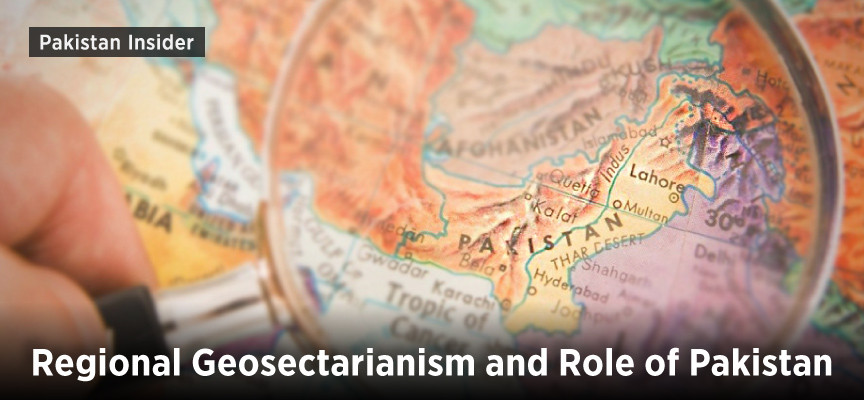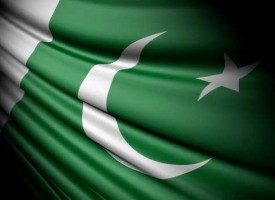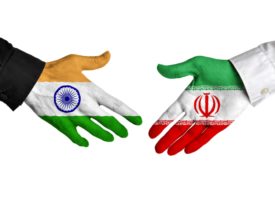We live in precarious times. The advent of the Internet was meant to promote the concept of a ‘global village’ but alas, here too the elements of hatred, hostility and strife spared no opportunity to spread discord and discontent rampaging across the Muslim world.
With the emergence of two radically opposing sub-factions within Islam (Wahhabi and Shia schools of thought) emerged fault lines which were otherwise hidden from the public eye. These schisms within the Muslim world were exploited as viciously by the religious clergy as it was by outside forces. The Sunnis were further split up into Deobandi, Barelvi, Ahle-e-Hadith (Salafi/Wahhabi) whereas the Shias were divided into Ithna Ashari (Twelvers), Zaidis, Ismailis (Aga Khanis), etc.
History of Regional Geosectarianism
Before the Kingdom of Saudi Arabia (KSA) and Islamic Republic of Iran had come into existence in the form of nation states as they are today, KSA (then known as Hijaz) was ruled by the Sunni Ottoman Turks and Iran was controlled first by the Safavids and later Qajar dynasties, both of which were Shiite.
The first recorded Sunni-Shia geopolitical war was fought between 1532 and 1555 (a span of 23 years) between the Ottoman Empire led by Suleiman the Magnificent on one side and Tahmasp I of the Safavid Empire on the other. It was triggered by what can now be described the establishment of a Safavid “satellite state” in the Turkish mainland vis a vis Bey of Bitlis (it had opted for Persian protection, similar to what Assad regime in Syria has been doing). The Safavid ruler Tahmasp had killed the Governor of Baghdad loyal to Suleiman (similar to the killing of Saddam Hussein in Iraq by Iranian and US forces working in tandem). Prior to these developments, Tashmasp’s father Ismail I had tried to forge a geostrategic alliance with the Hapsburg Empire of Charles V. The latter region (Hapsburg Empire) comprised areas covering 19 present day countries including Austria, Belgium, Croatia, Czech Republic, France, Germany, Italy, Luxembourg, Netherlands, Ukraine, Switzerland, etc. We may hence consider it in the present world geography as an Iranian alliance with NATO.
After 23 years of continuous and meaningless fighting, Suleiman (Ottoman head) and Tahmasp (Safavid head) agreed on a peace treaty known as “Peace of Amasya” that was signed and put into immediate effect on May 29, 1555. It defined both empires’ borders and remained resourceful for the next two decades. Another war eruped between 1623 and 1639 (16 years) over the control of Mesopotamia (areas of present day Iraq, Syria and Kuwait). This too, ceased, with the signing of the “Treaty of Zuhab” (“Kasr-e-Shireen”). However, despite signing these crucial treaties, the Ottomans and Safavids continued remaining suspicious of their intentions.
During the reign of Fath Ali Shah Qajar, the second Qajar sovereign, Persia signed the peace-oriented Treaties of Erzurum with the Ottoman Empire, first in 1823 and later in 1847 under Mohammad Shah Qajar. These resulted in almost a century of peace.
The Arab Revolt of 1916-1918 spearheaded by Sharif Hussein ibn Ali and his sons in Hijaz (Makkah, Madinah and adjoinining zones) in connivance with British imperialist forces effectively crused the centuries-old Ottoman caliphate once and for all. This was followed in 1932 by the loot, plunder and killings by Ibn Saud who declared himself monarch of the “Kingdom of Saudi Arabia”. When American surveyors discovered large oil reserves 5 years later, the House of Saud eventually appeared, holding power to this day derived from trillions pocketed in oil sale revenues. The House of Saud has traditionally been complemented with the religious establishment, descendants of Muhammad ibn Abd al-Wahhab, founder of an extremist school of thought known popularly as “Wahhabism”. It effectively created severe discontent among Sunnis until the emergence of Ayatollah Ruhollah Khomeini as head of the “Islamic Republic” of Iran in 1979 created further panic among Muslims because it was a historical repeat of what their forefathers had earlier witnessed during Ottoman-Safavid and Ottoman-Qajar dynasties.
Present World Scenario
History has a habit of repeating itself and this is what we all conveniently forget. The occasional stifling between Riyadh (the de-facto “Sunni” core) and Tehran (de-facto “Shia” core) has been going on since long. There is nothing surprising, shocking or even unbelievable about this new predicament.
Let me share a few examples:
- In November 2010, leaked embassy cables revealed that late Saudi King Abdullah had urged the US to attack Iran’s nuclear infrastructure, requests which were obviously never considered. Despite these incendiary facts surfacing to light, Iran and KSA never faced each other off in a regional war (Source)
- In October 2011, the FBI had uncovered an Iranian plot to assassinate Saudi Ambassador to the US, Adel al-Jubeir (who now ironically is the Saudi Foreign Minister). That revelation had also sparked widespread concern of the tension crossing its threshold between both the countries (Source)
- In June 2012, Saudi Arabia had executed 4 Iranian nationals for drug trafficking. The move was also seen as threatening for regional peace but it eventually died down (Source)
We also have three further ‘irritants’ between the two:
- The successful political solution to Iran’s nuclear ambitions
- Iran’s involvement in Bahrain
- Iran’s support to Houthis in Yemen
KSA is rightly paranoid about Iran forming a ‘Shiite Crescent’ around its sphere of influence. But then again, when viewed from Tehran’s perspective, Saudi Arabia and its numerous allies in the Gulf Cooperation Council (GCC) have also been using proxy groups such as Al Qaeda, Jabhat al-Nusrah, Free Syrian Army, Jaish-ul-Adl et al to conduct irregular warfare on states either sympathetic to, or with a considerable inclination towards, Iran. Take for example Lebanon where Iran-backed Hezbollah is being curbed by providing billions to the Lebanese state army, Bahrain where an Iran-backed uprising is being suppressed by providing material and logistics support to the state armed forces or Yemen, where the Houthis supported by Tehran are being aided by the IRGC’s Quds Force as it is supporting Bashar al-Assad’s regime in Syria or the government in Baghdad, Iraq.
Once we zoom out of this confusing potpourri of state-sponsored proxy groups operating for geopolitical and eventually geo-economic influence in the region, we will slowly but gradually come to realize the most disturbing truth: Riyadh and Tehran thrive off each other’s enmity. As bizarre or ridiculous as it may sound, the very legitimacy of the autocratic regimes in Saudi Arabia and Iran is dependent upon the amount of hatred and defamation they preach against each other.
If one recalls the dark yet witty story Satan, authored by Khalil Gibran, the religious cleric needs Lucifer to survive so he could retain the financial and psychological control over his subjects and followers. Similarly, the religious clergy hailing from Najd which directs Saudi Arabia’s politico-ideological foreign policy and their rivals hailing from Qom in Iran have common interests: subjugating the masses to their camp by reviling the other. But what if that “other” is attacked or destroyed?
John Bell, Director of the Middle East Program at Toledo International Centre for Peace in Madrid, Spain, made an interesting observation in an op-ed dated March 30, 2015. He noted:
“…in the region itself, all nations, including Iran with its presumptive rise, may well find that, despite the appetite for and illusion of control, they will be victims to a greater law: no one in the Middle East will agree to be ruled by another, and the instincts for detecting this are finely honed, bordering on the paranoid. No one can sit on the throne for long, and certainly not comfortably.
The “Game of Thrones” and all its attendant wiles, chatter, and analyses, may appear attractive on television, and in the halls of regional power, but it’s a loser in the real world. This is especially the case in an era where economic, technological and cultural development, rather than control over your neighbour, defines influence and power.
The reality, beyond the game, is that the 21st century is rolling forward without the Middle East, its geopolitics, and its victimised people.”
This is exactly why, despite island disputes with Iran, Arab sheikhdoms like the United Arab Emirates (UAE) have focused more on internal development and reform instead of going into all-out confrontation with Tehran. Oman, as a neutral Arab country, instead facilitated secret talks to reach a peaceful agreement over the three islands in the Straight of Hormuz.
And then again, perhaps the most important fact to bear in mind is that the Saudis and Iranians both have this probability in mind that they both will run out of cash until and unless they find other diversified means of income instead of continued reliance on oil. Hence, pragmatically speaking, will these geosectarian autocracies risk spending exhausting their present potential in a showdown which would hurt them the most, besides setting the region on fire?
As far as I’ve been able to comprehend the changing trends in global geodynamics, they are too sly to even think of such an option. They have many interests to secure and weakened economies would eventually de-seat them in their own homelands. For the time being, it appears that the vast political influence both Saudi Arabia and Iran wield cloaked under the guise of religion, will remain as the secondary source of revenue and for that, I reiterate, they need each other’s very existence to survive.
As Mustafa al-Labbad observed in March 2014: “Politics has always been and will remain the art of the possible. State interests have never been determined by ideology. Saudi and Iranian policymakers have probably heard of Churchill’s statement: “We have no lasting friends, no lasting enemies, only lasting interests.” We can confidently say that the Saudi-Iranian confrontation is headed for calm on the regional fronts in the foreseeable future, no matter how bleak the picture looks now.”
Riyadh is the Yin to Tehran’s Yang, and vice versa.
Conclusion
It would undoubtedly be very prudent of Pakistan to stay as far away as possible from this geosectarian hogwash which will end up tainting its own image as a neutral, mature and responsible country, the only nuclear-armed Muslim-majority state.
Mr Sartaj Aziz, Adviser to the Pakistani Prime Minister on Foreign Affairs, said that the Saudi-Iran standoff would only benefit terrorists. This comes after the Foreign Office issued a brief statement calling for a peaceful resolution of the crisis “in the larger interest of Muslim unity”.
The same neutral resolve which Pakistan showed during the so-called Arab Spring and GCC’s Yemen War should be continued to prevent an imbalance in its already fragile national security landscape. However, there is no harm in making sincere, concerted efforts to mediate peace between the two disgruntled countries.
image credit: gettyimages








Good article!
In my opinion religion follows national interest. Religion sectarianism is just a symptom that represent diverging interest of underlying population. I do believe that Pakistan cannot mediate between these two. It is better to play neutral.
The war between Iran and KSA will continue for a long time.
> House of Saud is more divided than ever.
> ISIS will make inroads into KSA by the end of 2016.
> Oil prices will keep pressure on the Saudis.
I strongly disagree with Mustafa al-Labbad. The opposing religious views are actually representations of divergent state-interests. Both states will keep pushing against each other until one is totally consumed — which I believe would be KSA.
Very well research on the history of geosectarianism between totalitarian Wahabi Saudi and Shia Iran. The worrying part of this conflict is that the followers of both the sects in Pakistan take it as a war between two sects rather than two States. Their sectarian ideology dominates the national pride and interests. Both the countries shift proxy war in Pakistan being the most fertile place to settle their scores with bare minimum investments as compared to open war. The unilateral announced alliance of 34 Islamic Countries, apparently fighting the terrorism, is another game play to isolate Iran and the countries having leanings towards it. This alliance does not include Iran, Iraq and Syria and so on. On one hand Pakistani government, especially the rulers, have special bonding with Saudi Arabia and AlSaud House but at the same time Iran is our immediate neighbor and an Islamic country. Pakistan, therefore cannot ignore the importance of Iran vis-a-vis geopolitical relations. I believe that all sane people in Pakistan are aware of the effects on Pakistan if it opted to side with either party. The best way forward is that Pakistan put all its efforts to mediate between both the countries. I also agree with the statement of Mr. Sartaj Aziz that the current situation is very conducive for the terrorists including IS (Daesh) to exploit it to their benefits.